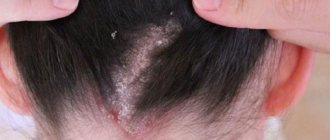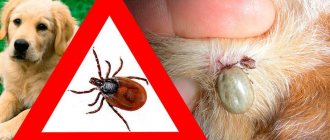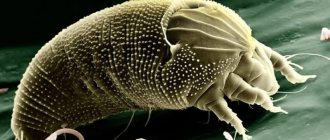What is an eye mite
Photo 1. Demodex eye mite.
Eye mite
– red mite of the genus Demodex, the smallest parasitic arthropod. The photo shows an adult specimen, its length is 0.3-0.4 mm, its body is elongated, translucent, covered with scales. Fertilization is internal. The life cycle is two to three weeks.
According to recent studies, these mites are constantly present in the skin of all mammals without manifesting themselves in any way. With certain disturbances in the functioning of the immune system, they are activated, causing a disease - demodicosis. In humans, they live mainly on the face, localized in the sebaceous and meibomian glands, and hair follicles. They feed on the secretions of the sebaceous glands and epidermal cells. At night they come to the surface to mate. Able to move on the skin.
Symptoms, signs, diagnosis
Demodex is not always dangerous for humans. Chinese scientists believe that in normal quantities it is even beneficial for the skin - with its help, PH is maintained at normal levels, a biocenosis is created that prevents the appearance of pathogenic flora. But as soon as the body’s immune system fails, the tick immediately begins its active activity .
Demodecosis can be primary and secondary.
In the primary form, the symptoms of the disease appear on healthy facial skin, that is, the problem is diagnosed for the first time. Secondary demodicosis is an exacerbation of the chronic form of the disease. Most often this happens in spring and autumn.
Manifestations of demodicosis:
- redness and swelling of the skin of the eyelids;
- gluing eyelashes;
- formation of a scaly muff at the base of the eyelashes;
- flaky crust on the roots of the eyelashes;
- excessive eyelash loss (about 10 per day);
- blurred vision;
- increased eye fatigue.
The symptoms of demodicosis are similar to those of conjunctivitis. But after treatment, conjunctivitis does not manifest itself in the body in any way, unlike diseases caused by ticks.
To confirm the diagnosis:
- 2 eyelashes are selected from the lower and upper eyelids;
- analyze the condition of the eyelashes under a microscope.
The tick cannot be seen with the naked eye, but under magnification it can be easily identified by its movement. It is important not only to identify the tick, but also to analyze its numbers.
It is generally accepted that 6 mites on 4 eyelashes taken for analysis is the norm. More numerous colonies can cause painful conditions, in which case treatment is required.
Reasons for the development of demodicosis
Normally, the number of mites is regulated by the immune mechanism of the human carrier. Factors that reduce immunity and provoke the development of demodicosis can be external or internal.
External
- long-term use of antibiotics, hormonal drugs;
- abuse of cosmetic procedures - peeling, facial cleansing;
- prolonged infrared or ultraviolet irradiation;
- eye surgeries.
Domestic
- bacterial and viral infections;
- allergy;
- chronic gastrointestinal diseases;
- stress;
- keratoconjunctivitis;
- pregnancy;
- hormonal disorders.
Folk recipes
Treatment with folk remedies offers several methods:
- cleansing eyelashes and eyes of scales using alcohol tincture of calendula or eucalyptus;
- softening the skin when rubbing burdock oil;
- homemade ointment is prepared from 2 Trichopolum tablets crushed into powder and 1 tbsp. l. castor oil, treat the eyelids at night, in the morning - everything is washed off;
- a remedy with celandine is prepared from fresh roots and refined oil in equal proportions, the jar with the mixture should be kept in the sun for 2 weeks, then strained and poured into a dark bottle, stored in the refrigerator; before applying to the eyelids and around the eyes, the product is mixed with sour cream;
- effective medicinal decoction of wormwood: 2 tbsp. l chopped dry herbs per 1 l of boiling water, cook for 5 minutes. and leave for 3 hours, filter through cheesecloth; The decoction is recommended to be taken orally for 6 days according to the following scheme: 1st – 0.5 tbsp. hourly, 2nd – 0.5 tbsp. every 2 hours; 3-6th – 0.5 tbsp. every 3 hours; The drink can be sweetened with honey.
Folk recipes against eyelash mites
Recipes for preparing solutions for compresses and lotions for eyelids:
- boil 1 tsp. oak bark in 1 tbsp. hot water for 5 minutes. – the decoction is used for lotions, which are applied in the form of a soaked napkin on the eyelids;
- a compress of aloe juice, squeezed onto a sterile piece of bandage, is done several times a day to relieve inflammation;
- grated fresh garlic, wrapped in a bandage, is applied for 30 minutes, the lotion should be changed every 10 minutes.
Important!
During the treatment period, you should always carry a package of disposable soft wipes with you, with which you can remove discharge from the eyes. Be sure to wipe the frames of your glasses. Contraindicated in the treatment of eyelash mites: sauna, steam bath, tanning, alcohol and smoking.
Symptoms
Photo 2. Eye mites - symptoms of blepharitis.
In the initial stage of demodectic blepharitis, clinical manifestations are practically absent. Subsequently, with the increase in the reproduction of ticks, their waste products cause the appearance of the following symptoms:
- itching and burning of the eyes;
- redness, swelling, inflammation of the edges of the eyelids;
- sticky, thick discharge that accumulates in the corners of the eyes;
- sticking of eyelashes, appearance of scales and crusts on them;
- eyelash loss;
- dry eye syndrome.
Causes and symptoms of demodicosis
The cause of the development of the disease and the proliferation of mites in the eyelashes can be favorable conditions that are created during certain diseases in humans:
- gastrointestinal diseases;
- hormonal imbalance or disorder;
- infectious diseases;
- decreased immunity;
- stressful situation;
- development of chronic infection (gastritis, sinusitis, pharyngitis, etc.);
- change in climate zone, increased air temperature and humidity.
Reasons for the development of reproduction of eyelash mites.
Routes of transmission of eyelash mites:
- when visiting public places with high humidity (baths and saunas);
- using other people's cosmetics and hygiene items (towels, bedding), unsterilized instruments in beauty salons;
- contact with a sick person or animal.
On a note!
The maximum period of demodex activity is spring and autumn. Demodicosis can appear on the eyebrows, chin, ears and nasolabial folds.
The main symptoms of eyelash mites:
- chronic eye fatigue, photophobia;
- itching and swelling in the area of the eyelids and eyelashes;
- redness and inflammation of the eyelids along the human eyelash line;
- irritating effects are caused by various cosmetic (using creams, etc.) and water procedures (washing);
- mucus secretes from the eyes and turns into yellow crusts, due to which the eyelashes stick together and fall off;
- vision deteriorates.
If you have the listed symptoms, it is better not to delay treatment - you should immediately contact a dermatologist and ophthalmologist, who can perform a laboratory analysis of a scraping taken from the eyelashes for the presence of eyelash parasites.
Pathogenesis
Anatomically, blepharitis is divided into anterior and posterior. Invasion of the eyelash follicles is referred to as anterior blepharitis. In case of damage to the meibomian glands - about the posterior one.
Factors determining the negative impact:
- Mechanical damage.
Eating epithelial cells by mites disrupts the direction of eyelash growth, increases their loss, and contributes to the development of trichiasis. The internal cavity of the hair follicles increases, hyperkeratosis and mild perifolliculitis occur. Mechanical blockage of the meibomian gland ducts by parasites causes their hypersecretion and inflammation - chalazion.
- Secondary infection.
Tick-borne blepharitis is often complicated by a secondary infection, staphylococcal or streptococcal, which can lead to the development of purulent conjunctivitis and ulcerative blepharitis.
- Allergic reaction.
Mite waste products and dead individuals have a toxic-allergic effect on the membranes of the eye, and eyelid dermatitis develops.
Prevention and possible consequences
Demodicosis in humans provokes purulent inflammation of the skin, hair follicles, and conjunctiva of the eyes. In the absence of adequate treatment, mites on the eyelashes penetrate deep into the soft tissues, causing acne. Experts have proven that the causative agent of demodicosis plays a significant role in the occurrence of such diseases:
- chronic blepharitis;
- blepharoconjunctivitis;
- microabscesses.
As the disease progresses, ulcers form under the eyes, causing swelling of the surface and inner layers of the skin. Over time, the mucous membrane of the eye becomes involved in the process. If you do not contact a specialist in a timely manner, vision problems may arise.
To prevent reactivation of the microscopic mite, the following preventive measures must be observed:
- disinfection of glasses and razors;
- regular change of pillowcases;
- ironing towels;
- disposal of cosmetics infected with mites.
Using tar soap instead of foam for washing reduces the likelihood of relapse of demodectic blepharitis. Periodic use of antiseptic eye drops also prevents the mite from penetrating the meibomian glands.
Laboratory diagnostics
If you have a history of persistent styes, eyelash loss, chronic acne and rosacea, then demodicosis can be suspected with a high degree of probability. However, laboratory testing is necessary for an accurate diagnosis.
Preparing for diagnosis
- Two days before the procedure, it is prohibited to apply decorative and medicinal cosmetics to the face.
- Do not apply eye drops the day before.
- Do not wash or wet your face for 24 hours.
Methodology
The procedure is carried out in the evening, when mites crawl to the surface of the skin and are easier to detect. Eight cilia are taken from each eye - four from the upper eyelid and four from the lower eyelid, placed on a glass slide in an alkali solution and examined under a microscope at low magnification.
Interpretation of the result
- The absence of mites, eggs, larvae - the result is negative.
- The presence of empty egg shells is a positive result, but requires repeating the analysis.
- The presence of at least one tick – demodicosis is diagnosed.
- Detection of more than ten mites – pronounced infestation.
Attention! A negative result does not always guarantee the absence of parasites.
Diagnostics
Demodicosis of the eye requires a visual examination, ophthalmological and laboratory testing. The eyelash mite Demodex provokes the formation of purulent masses and scales on the eyelids. If a disease is suspected, the following diagnostic methods are used:
- Biomicroscopy of the eye is an ophthalmological examination, through which the condition of the vitreous body, fundus and conjunctiva is assessed. If a tick parasitizes the eyelids for a long period, this is indicated by inflammatory and degenerative changes in the tissues.
- Microscopic examination is a diagnostic method that identifies parasitic mites in hair follicles. To carry it out, samples of the affected tissue are taken for further examination under a microscope.
- A puncture biopsy is a histological examination of the contents of the sebaceous or meibomian glands. Detects acne and its metabolic products in the thickness of the skin.
- Acarogram - counting the number of larvae and adults of parasitic mites on the skin. If more than 5-6 parasites are found in 1 cm2 of tissue, demodectic blepharitis is diagnosed.
In case of multiple purulent discharge, demodex on the eyelashes is determined using a tape test. To identify secondary changes in the mucous membranes of the eyes and skin, additional laboratory tests are carried out.
Treatment
The treatment is complex and long-term. Does not always give positive results, relapses are possible. According to the doctor’s recommendations, drug treatment is combined with traditional medicine methods. Personal hygiene plays an important role.
Hygiene
It is necessary to get rid of all previous cosmetics, since they may contain live parasites. After washing your face, you should wipe your face not with fabric towels, but with disposable paper towels. Change bed linen as often as possible, if possible boil or iron with a hot iron on both sides.
Drug treatment
- Cholinomimetics
– Physostigmine, Phosphacol, Pilocarpine. They are used to treat glaucoma, but also stimulate the release of meibomian glands from secretions and parasites, and paralyze the muscles of ticks.
- Metronidazole.
Has antimicrobial and anti-acne effects. It is prescribed internally in the form of tablets and externally to lubricate the edges of the eyelids with gel. Effective against Demodex, but the mechanism of action is unknown.
- Antibiotic eye drops
– Ciprofloxacin, Levomycetin, Tobrex. Necessary for the prevention and treatment of secondary bacterial infection.
- Artificial tear
– moisturizes the conjunctiva for dry eye syndrome.
- Acaricides
– Demalan, Demazol, Blefarogel No. 2. Helps remove mites from eyelash follicles.
- Corticosteroids and antihistamines
– Dexamethasone, Diphenhydramine. Suppresses delayed allergic reactions.
- Multivitamins.
Increases immunity.
In addition, regular massage of the eyelids helps remove mites with glandular fluid. Subsequent washing with tar soap has an insecticidal effect.
It is important! During treatment, visiting baths, saunas, solariums, and public swimming pools is prohibited. You should also not take hot baths.
Folk remedies
- Wormwood decoction is an effective traditional medicine for demodicosis.
Chop two tablespoons of leaves, add a liter of water, boil, keep on fire for several minutes, leave for two hours. The freshly prepared decoction is drunk for 6 days - on the first day, 50 ml every hour, on the second day, 50 ml every two hours, on the third and all subsequent days, 50 ml every three hours.
- Laundry soap mask.
Beat foam from a bar of soap in warm water. Apply 4-5 layers to the face, allowing each layer to dry. Leave until morning, rinse in the morning. Do it daily until complete recovery.
- Aloe juice. Mix with water 1:1
, apply eye lotions daily for 20 minutes.
- Tincture of calendula.
Using a cotton swab, carefully apply to the root zone of the eyelashes.
This article is for informational purposes only, please consult your doctor for details! Ask your doctor about contraindications and side effects.
Prevention
to wash and iron all linen at higher temperatures during treatment . This way you can reduce the risk of re-infection. It should be remembered that no matter how trite it sounds, hygiene can do a lot.
All things in contact with the face must be thermally treated. Remember that cosmetics should be individual, although it is better to avoid them altogether during treatment.
Ticks need a suitable habitat to develop. Therefore, if the surface of the skin near the eyelashes is inflamed, and protein breakdown products are found on it, then in such an environment the parasite lingers for a long time. Regular skin care will help bring it back to normal and make it inconvenient for mites to breed.
Don't forget that a good immune system can fight ticks much better than newfangled remedies. Therefore, take care of your health, observe the rules of personal hygiene, and then you will not need to think about treatment.
Eyelash mites - treatment
Because eyelash mite infestations are often asymptomatic, many people seek treatment only when the mites are multiplying in large numbers. Demodicosis can be diagnosed and treated.
The goal of treatment for demodectic blepharitis is the destruction of mites. To do this, your doctor may recommend:
- eyelid hygiene
- 1% sulfur ointment
- 1% mercuric oxide ointment
- pilocarpine gel
- iodized solutions
- warm compress
- intense pulsed light
- ivermectin
- tea tree oil
According to research, tea tree oil may be the only remedy to kill demodex mites. The oil has antibacterial, antifungal and anti-inflammatory effects that help treat this problem.
Inflammation of the eyelids can cause inflammation of the conjunctiva, which is called blepharoconjunctivitis.
Typical treatments for conjunctivitis, including antibiotics, antivirals, and ointments, may not be effective in treating blepharoconjunctivitis caused by Demodex.
Eyelash mites can also infect the cornea and cause demodectic keratitis. Some studies have shown that tea tree oil can kill eyelash mites and reduce inflammation of the ocular surface.
Other treatments may include:
- crotamiton cream
- permethrin cream
- topical metronidazole
- oral metronidazole
In severe cases, such as people with HIV, oral ivermectin may be effective.
Demodicosis disease
Demodicosis is a dermatological disease that affects human skin or hair. This pathology is characterized by a rash of acne, the appearance of ulcers on the skin of the face, back or chest, accompanied by severe itching.
Most often, demodex settles on:
- centuries;
- eyelashes;
- eyebrows;
- nasolabial folds;
- forehead;
- chin;
- ear canals.
Cutaneous form
Demodectic mange on human skin occurs only when immunity is reduced (even in a separate area of the skin), penetrating into the deepest layers of the skin.
Therefore, in order to establish an accurate diagnosis, the mere presence of the pathogen is not enough (it is found in the secretions of the sebaceous glands in most absolutely healthy people), it is necessary to detect the signs and symptoms of this pathology.
The cutaneous form of demodicosis begins with redness and dilation of capillaries in certain areas of the skin, after which it begins to peel off and blisters filled with liquid form. Purulent blisters may appear, the skin becomes uneven and there is severe itching. After some time, rosacea forms at the site of the skin lesion, which contributes to the development of seborrhea.
The favorite localization areas for demodex mites are: eyelids, nose, cheeks, eyebrows, external auditory canal, chin, forehead, back. As the pathology develops on the skin, demodectic blepharitis may begin, affecting the eyeball.
Ophthalmic form
Very often demodicosis can be found on the mucous membrane of the eye. In this situation, cosmetics, any creams and ultraviolet rays only worsen the condition. Demodicosis of the eyes can occur alone or together with demodicosis of the skin.











